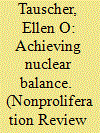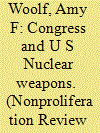| Srl | Item |
| 1 |
ID:
079628


|
|
|
|
|
| Publication |
2007.
|
| Summary/Abstract |
One of the most important questions affecting U.S. national security is the future size of the U.S. nuclear stockpile. While there is clear consensus within the U.S. government on the need to reduce the size of the arsenal, there is none on the best path to achieve these cuts; on the type of deterrent necessary to deal with future threats; or on the size of the production complex needed to support that arsenal. Creating a strategic commission to review these questions, as contemplated in the Fiscal 2008 House Defense Authorization bill, is a necessary first step to establish a sensible nuclear policy. The Reliable Replacement Warhead, which has the potential to transform the complex while preserving the current moratorium on nuclear testing, is a program worth exploring further if it stays within congressionally mandated bounds. As Congress considers both programmatic and policy matters related to U.S. nuclear weapons, it is vital that we also renew and strengthen U.S. leadership on nuclear nonproliferation
|
|
|
|
|
|
|
|
|
|
|
|
|
|
|
|
| 2 |
ID:
079627


|
|
|
|
|
| Publication |
2007.
|
| Summary/Abstract |
The U.S. Congress, charged with overseeing U.S. nuclear weapons policy and programs, usually addresses such policies and programs through the annual authorization and appropriations process, focusing mostly on questions of how many and what types of weapons the United States should deploy, with little attention paid to questions about nuclear weapons strategy, doctrine, and policy. The oversight process has brought about some significant changes in the plans for U.S. nuclear weapons, including the elimination of funding for the Robust Nuclear Earth Penetrator study and the shift of that funding into a study of the Reliable Replacement Warhead. But with the focus on authorizations and appropriations, along with the divided jurisdiction over nuclear weapons policy and programs in congressional committees, Congress has not, either recently or during the Cold War and post-Cold War eras, conducted a more comprehensive review of U.S. nuclear weapons strategy, policy, or force structure. Changes in committee jurisdictions could affect the oversight process, but as long as nuclear weapons policy and programs remain a relatively low priority for most members of Congress, and the country at large, it is unlikely that Congress will pursue such a comprehensive debate
|
|
|
|
|
|
|
|
|
|
|
|
|
|
|
|
| 3 |
ID:
077790


|
|
|
|
|
| Publication |
2007.
|
| Summary/Abstract |
The stage may be set for what could be a historic turning point in America's reliance on nuclear weapons to meet its fundamental national security interests. Proponents of a refurbished nuclear stockpile and infrastructure are convinced that nuclear weapons will remain central to U.S. security interests, yet they admit that there is no national consensus on the need for and role of nuclear weapons. Nuclear opponents are gravely concerned that to the extent nuclear refurbishment creates a global perception that nuclear weapons remain essential instruments, it will eviscerate nuclear nonproliferation measures precisely at a time when nuclear ambitions are growing. Moreover, opponents see deterrence through advanced conventional weapons as decisively more credible than any nuclear alternative. With hopes of elevating discourse to the national level, this article examines the key current arguments pro and con within the specialist community and forecasts changes in the U.S. nuclear arsenal over the next decade. It concludes with a brief prognosis on prospects for complete nuclear disarmament.
|
|
|
|
|
|
|
|
|
|
|
|
|
|
|
|